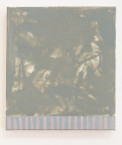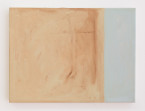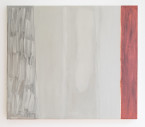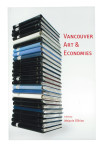Artspeak
Marina Roy
Marina Roy is Vancouver-based artist and writer whose work explores the intersection between language and visual art. She received her BA in French Literature at Université Laval, a BFA from the Nova Scotia College of Art and Design, and her MFA from the University of British Columbia. She has shown nationally and internationally, including the Vancouver Art Gallery, Contemporary Art Gallery, the Or Gallery Berlin, Gallery Sumukha, Chennai & Bengaluru, India, and Chisenhale Gallery, London. Roy was recipient of the VIVA award in 2010. In 2001 she published sign after the x (Artspeak/Arsenal Pulp Press), a book that revolves around the letter X and its multiple meanings. She is currently working on the next book, titled Queuejumping. She is Associate Professor of Visual Art at the Department of Art History, Visual Art and Theory at the University of British Columbia.
Exhibitions
-
ALEESA COHENE, DEREK DUNLOP, DEBORAH EDMEADES, MARINA ROY
April 2–May 21, 2016Making art is different from other forms of work. Some would question whether it is even working at all. Georges Bataille speaks of art as squandered energy, offered without instrumental purpose, counter to that productivity contributing to survival and to social life.
According to Elizabeth Grosz, an aesthetic expressive exuberance originates with animals, in the many evolutionary strategies undertaken by sexual selection. The extraordinary biodiversity arising on our planet expresses itself according to which bodies succeed in passing on their genetic information in new combinations in any given environment. Certain traits will be deemed more advantageous while others more attractive, these qualities getting passed on through the sexual reproduction. Some traits are more behavioural and therefore passed on by imitation (e.g. culture). These expressions of life were made possible by the conditions on our planet, situated in a Goldilocks zone—perhaps nothing more than a glitch in the history of the universe. The sun gives freely of its energy, throwing into being an inordinate range of life forms, and an abundance of consumables. This excess is experienced as aesthetic sensuous pleasure thanks to an infinite number of material combinations for display, manipulation, or expenditure.
While expressive extravagance in nature might be largely limited to chemical affinity, and flora and fauna biology, it extends itself prosthetically for humans in the production of culture. Bataille speaks of culture negating nature:
“I submit as a principle of incontestable fact that man is an animal who does not simply accept the natural given, [but] who negates it. In this way, he changes the natural external world; he derives from it tools and manufactures objects that form a new world, the human world. Concurrently, man negates himself; he trains himself; he refuses, for example, to give to the satisfaction of his animal needs, that free course on which the animal places no restraint. It still must be granted that the two negations by man—of the given world and of his own animality—are linked.”[1]
Human negation of nature and of their innate animality arises no doubt from an acute sense of mortality—a reaction that might explain Bataille’s use of the word “accursed” in the title of his three-volume work The Accursed Share (La part maudite, 1949). The “accursed share” points to the un-recuperable expenditure of material energy at the foundation of art (as well as non-reproductive erotic sexuality), but also points to a common desire to surpass one’s natural limits. It is what humans come to share based on social implication—involvement in any number of cultural rituals. In former times, this share would have expressed itself in the form of sacrificial offerings of precious foodstuffs, objects, animals, and even human life, to please or appease the gods. Art likely arose as activity/legacy co-extensive to such cult rituals. Cultural production of prosthetic, simulated, and artificial life-forms also belie an accursedness—the desire to surpass and/or substitute what is naturally given through manipulation and consumption of life’s surplus.
While the abstract notion of negation central to human culture (of the European variety at least) is rarely recognized outright as humans go about their day-to-day existence, philosophers with a surplus of contemplative time on their hands have claimed negation as foundational to the ‘progress’ of human thought. No longer limited to a life of labour or mere survival, culture binds social being under a common accursedness, in a common desire to overcome nature through making “changes to the natural external world.” At present, we find ourselves accursed with the fruits and dregs of these excesses under the domination of capital—no longer simply negation so much as ensuring the future death sentence of myriad species.
Sacrifice was the first line of defense against all-out conflict and disaster. The sun was seen to regain its balance during carefully executed rituals and transgressions, to ensure smooth transition between seasonal cycles. A little spilled blood kept forces in balance, any cataclysm at bay. Once the animistic dreams had faded, any deeply felt relation to the sacred was largely obfuscated by an even more elaborate system of substitution and exchange based on accumulation. Earthly treasures were extracted, utilized, and wasted in the name of human interests. There evolved a faith in human communality, enhanced by human works and labour, without any need for divine intervention or any recognition for the surrounding biosphere’s intricate web as foundational to life. Sacrifice remained a hidden reality decipherable in such rituals as consuming the daily news.
Art’s squandering of energy and materials to unproductive ends plays a large part in our shared accursedness. What position do humans occupy when they exit the realm of the animal? One might deduce quite generally: the realm of the law. It is how we came to negotiate a shared human condition, for better and for worse. Transgression breaks the tension of repressed desire and the tedium of abstract labour. Largely this is the labour one might not necessarily care about but which one understands as one’s social duty, one’s contribution to the economy—fulfilling the required hours in exchange for a paycheque. But then there’s the type of work that takes the form of a project to construct/project a vision of ‘the possible’ that breaks the cycle of social apathy and injustice. When capital gets its hands on it, the ethical nature of this activity largely disappears.
Art shares its accursedness with the law, in the defining of rules and limits, but art also takes on the role of pushing up against the law, pointing to transgression as a way forward, toward new freedoms. Art is useless to practical or instrumental concerns, and yet it is an essential sign of what it means to be human; when executed thoughtfully it expresses something inherently singular and historically contingent. It finds its most basic expression in material play—complexity accreting through technical innovation and historical consciousness. One might sense that the ‘play’ aspect has largely been ‘rehearsed’ and ‘iterated,’ as technologies are designed and come to be used by people in predictable ways. This is revealed when an artist asks, “How are social forces embedded in the body, and how do they find material form?”[2] How to address this in an artwork?
After centuries of calcified social convention and an increasing alignment with exhibition value, art came to claim an avant-garde status, making it its mission to counter high culture through propagating revolutionary ideals materially, with the ultimate goal of social upheaval, change, and even utopia. Not just desiring what the other desires (social mimesis) but breaking that cycle toward taking greater responsibility in enacting difference, even shifting the course of history.
Art’s ontology is rooted in humanity’s common lot and common origins. It has continued to be one of those sanctioned spaces of excess and contemplation, allowing the People to partake in shared experiences that delve, quite often, into bigger questions. While art continues to bring people together around a shared language of materials, images, and affect, any notion of the sacred might now be translated as some “fleshy remainder”[3] once central to sacrifice. At best, art’s responsibility is to this fleshy remainder.
I offer this essay as a framework for thinking about what these artworks might share despite their respective differences: a heightened sense of material aesthetic sensuousness and accursedness as point of departure. Works by Aleesa Cohene, Deborah Edmeades, and Derek Dunlop share a common desire to tap into the expressive vitality found within inanimate matter—how, through processes of artistic transformation, new affective material forms come to resonate in us. Brought together, these works shed light on the foundations of human representation in surplus, combined with attempts at redemption through intellectual engagement with this material surplus. In a world where virtually all life has been subsumed to capitalist ends, these artworks offer resistance to instrumental modes of thinking, making, and acting through highly idiosyncratic, materially sensitive modes of feeling and understanding.
[1] Georges Bataille, The Accursed Share, vol. II & III, NY: Zone Books, 1991, pp.52-53
[2] “Derek Dunlop: End-forms,” http://www.lkap.ca/derek-dunlop/
[3] Inspired by Eric Santner’s use of the term in On Creaturely Life (2006) and The Royal Remains (2011).
Postscript 66: Vanessa Kwan on The Accursed Share(PDF)
-
Once things are reduced to nothing…
MARINA ROY
August 1–August 31, 2013Ongoing installation in Artspeak’s windows while the gallery and office are closed for August.
“ONCE THINGS ARE REDUCED TO NOTHING THEY BEG YOU TO BE CONSCIOUS OF THEM AND ASK YOU TO COLONIZE THEM. THEIR LIFE HANGS BY NOTHING MORE THAN THE THREAD OF YOUR ATTENTION.”
—Bruno Latour, The Pasteurization of France (1988)Marina Roy’s new work brings Bruno Latour’s words into relation with a new site of viewing. Two sentences escape their original context within a book to collide with subjects who would not encounter the words otherwise. The words take on new meaning through their placement on the window, but also through imagery collaged on the reverse of the vinyl text, resulting in alternate networks of relations. The letters and words become hybrid creatures. This gesture is one of supplementing, but also of the aide-memoire. To memorize an author’s words by inserting them into an unfamiliar visual frame, associating them with a new picture, translating and materializing them within a lived situation.
Why “things”? Things are not just things as we have come to objectify them. For Latour they have agency. Things refer to a more ancient meaning of “assembly” or “gathering.” It relates to things of concern; that which brings people together to discuss what binds and divides them. Roy’s work is no exception—it is a gathering of particular things with public issues in mind. There are the actual materials used: vinyl film, window glass, temporary wall, and mirror; then there is the formation of the text and representational imagery from vinyl material, and how the text and imagery reveal themselves. The things represented on the underside of the text illustrate a procession of “colonized” objects and humans, subservient to the forces of consumerist culture. This procession of things is floating on an abstract amalgam of “leftovers”—the pieces of vinyl left over once the process and application of cutout imagery is complete.
In aspiring to a democratization of relations between human and non-human entities, Latour outlines how things can enter into complex new relations. In his book We Have Never Been Modern (1991), Latour claims that, under the purview of a symmetrical anthropology, the destruction and repression of nature and other cultures are no longer the aim, as it was under the modernist project. Nature and culture are no longer separated by the Great Divide. They all become part of the Middle Kingdom of quasi-objects and quasi-subjects. “It is time, perhaps, to speak of democracy again, but of a democracy extended to things.”
-
DANH VO
September 8–October 27, 201220 janvier 1861.
J.M.JTrès cher, très honoré et bien-aimé Père,
Puisque ma sentence se fait encore attendre, je veux vous addresser un nouvel adieu, qui sera probablement le dernier. Les jours de ma prison s’écoulent paisiblement. Tous ceux qui m’entourent m’honorent, un bon nombre m’aiment. Depuis le grand mandarin jusqu’au dernier soldat, tous regrettent que la loi du royaume me condamne à la mort. Je n’ai point eu à endurer de tortures, comme beaucoup de mes frères. Un léger coup de sabre séparera ma tête, comme une fleur printanière que le Maître du jardin cueille pour son plaisir. Nous sommes tous des fleurs plantées sur cette terre que Dieu cueille en son temps, un peu plus tôt, un peu plus tard. Autre est la rose empourprée, autre le lys virginal, autre l’humble violette. Tâchons tous de plaire, selon le parfum ou l’éclat qui nous sont donnés, au souverain Seigneur et Maître.
Je vous souhaite, cher Père, une longue, paisible et vertueuse vieillesse. Portez doucement la croix de cette vie, à la suite de Jésus, jusqu’au calvaire d’un heureux trépas. Père et fils se reverront au paradis. Moi, petit éphémère, je m’en vais le premier. Adieu.
Votre très dévoué et respectueux fils.
J. Théophane Vénard
m.s. -
Persistence: An Archive of Feminist Practices in Vancouver
JESSIE CARYL, CRISTA DAHL, JENNIFER FISHER, ELIZABETH MACKENZIE, MARINA ROY
November 8–January 31, 2009Organized by Artspeak with Jessie Caryl, Crista Dahl, Jennifer Fisher, Elizabeth MacKenzie and Marina Roy
Persistence: An Archive of Feminist Practices in Vancouver is part of a citywide dialogue with the exhibition WACK! Art and the Feminist Revolution. WACK!, at the Vancouver Art Gallery, explores the formation, development and impact of feminism in post-war international contemporary art from 1965 to 1980. Artspeak is presenting a collection of printed material that offers a local perspective on feminist art production from the 1970s to the early 90s.
Artspeak will exhibit ephemera and texts that span the creative experimentation, political action and critical inquiry of a wide array of feminist artists and arts collectives working in Vancouver. Including production catalogues, screening guides, event posters, announcements, as well as other documents, this collection of material allows for an examination of the dynamic contribution local practices have made to both the feminist project and creative culture at large.
Persistence: An Archive of Feminist Practices in Vancouver has been organized to compliment VIVO Media Arts Centre’s parallel screening project November 7-8 Persistent Resistence: Early Feminist Video in Vancouver and takes its materials largely from VIVO’s archives. See www.vivomediaarts.com for more information.
-
MARINA ROY
March 17–April 21, 2001This exhibition, titled with the punctuation “…”, takes as its central theme the medium of typography and the form of the book. A series of altered books, titled Thumbsketches sculpturally intervenes in familiar texts, evoking bodily memories of books as sensual and intimate objects. The artist has drawn on the cut ends of paperback editions of such tomes as Balzac’s Lost Illusions and The Complete Poems of Keats. When pressed behind plexiglas mounts, the drawings stretch and splay in animated shifts of perspective. The work leans upon and skews our associations of revered texts with irreverent, often scatological defacements.
A companion work, a large canvas titled The following…, uses hot foil stamped letters arranged in a grid. The text is taken from Michel Foucault’s Les mots et les choses wherein he describes the painting Las Meninas by Velasquez. One word flows into another without punctuation marks and new words are created in the process, breaking down the authority of the descriptive text. The canvas, similar in scale to Las Meninas, comments on the differences in the use of allegory in the 17th and 20/21st centuries yet similarly ’hides’ the subject as the central focal point of power.
Marina Roy has exhibited her work nationally and internationally since 1992 and her practice includes a wide range of media including sculpture, printmaking, painting, photography and bookworks. She holds a Master’s Degree in Visual Art from University of British Columbia and completed her undergraduate studies at Nova Scotia College of Art and Design. Prior to her study in visual arts, she received a Bachelor of Arts in French Literature from Universite Laval. Roy currently teaches in the Visual Art Program at the University of Victoria.
Talks & Events
-
AMANDA DAWN CHRISTIE, ALEESA COHENE, DEBORAH EDMEADES
April 23, 2016Cineworks Studio
1131 Howe Street (lane entrance)Please join us for a screening of moving-image works by Amanda Dawn Christie, Aleesa Cohene, and Deborah Edmeades, and an artist talk by Cohene.
Presented in conjunction with the exhibition The accursed share, curated by Marina Roy.
-
JUAN A. GAITAN, MELANIE GILLIGAN, ANTONIA HIRSCH, HADLEY + MAXWELL, CANDICE HOPKINS, OLAF NICOLAI, MONIKA SZEWCZYK, JAN VERWOERT
November 18–November 20, 2011GreyChurch Collection & Project Space, 3092 Fraser Street, Vancouver
FRIDAY, NOVEMBER 18
7pm: Antonia Hirsch
8pm: Hadley+MaxwellSATURDAY, NOVEMBER 19
11am: Melanie Gilligan
12:30pm: Lunch
1:30pm: Monika Szewczyk
3pm: Olaf Nicolai
4:30pm: Clint Burnham (Response)SUNDAY, NOVEMBER 20
11am: Juan Gaitán
12:30pm: Lunch
1:30pm: Candice Hopkins
3pm: Jan Verwoert
4:30pm: Marina Roy (Response)Respondents:
Clint Burnham and Marina RoyArtspeak and Fillip present Intangible Economies, a three-day forum that broadens the notion of economy beyond its financial dimension. Initiated by Fillip Associate Editor Antonia Hirsch, the Intangible Economies series focuses on the multifarious forms of exchange fuelled by affect and desire and speculatively investigates the fundamental role these affective transactions play in modes of representation and, accordingly, in cultural production.
The premise of Intangible Economies is the assumption that personal relationships are produced by economic activity, and that conversely, affect, and in particular desire, generates economic transactions. In the wake of recent global financial crises, it seems critical to interrogate the notion of “value” in a broader sense. Intangible Economies seeks to tackle the difficult task of tracing the role of affect in economic exchanges relative to artistic production, while also enacting the unruly force of such transactions.
Intangible Economies was initially developed through a series of texts published in Fillip magazine over the past year and will culminate in a book anthology published as part of Fillip’s ongoing Folio Series in 2012.
The Intangible Economies forum is generously hosted by Jane Irwin and Ross Hill through the GreyChurch Collection & Project Space and made possible with support from the City of Vancouver and the Canada Council for the Arts. Additional support provided by Best Western Hotels.
-
ELI BORNOWSKY, JEFF DERKSEN, MARIA FUSCO, KEN LUM, SVEN LUTTICKEN, JON PYLYPCHUK, CATE RIMMER, MARINA ROY
August 1–August 31, 2011Please enjoy these summer reading “picks” from a selection of local and international artists and writers, including Eli Bornowsky, Jeff Derksen, Maria Fusco, Ken Lum, Sven Lutticken, Jon Pylypchuk, Cate Rimmer, and Marina Roy.
The PDF is available here.
-
Vancouver Art & Economies Book Launch
CLINT BURNHAM, RANDY LEE CUTLER, TIM LEE, MELANIE O'BRIAN, SADIRA RODRIGUES, MARINA ROY, SHARLA SAVA, REID SHIER, SHEPHERD STEINER, MICHAEL TURNER
March 28, 2007Wednesday, March 28, 7-9pm
At the Brickhouse, 730 Main Street
Please join Artspeak and Arsenal Pulp Press in celebrating the release of Vancouver Art & Economies, edited by Melanie O’Brian, with essays by Clint Burnham, Randy Lee Cutler, Tim Lee, Sadira Rodrigues, Marina Roy, Sharla Sava, Reid Shier, Shepherd Steiner and Michael Turner.
Vancouver Art & Economies was financially supported by the Canada Council for the Arts, the BC Arts Council, the City of Vancouver, Arts Now: Legacies Now 2010, the Spirit of BC Arts Fund and the Hamber Foundation.
-
Vancouver Art & Economies: A Forum
SHARLA SAVA, CLINT BURNHAM, MARINA ROY, TIM LEE, SADIRA RODRIGUES, RANDY LEE CUTLER, REID SHIER, SHEPHERD STEINER, MICHAEL TURNER
October 6–November 3, 2005Vancouver Art and Economies is a forum for critical dialogue on Vancouver’s contemporary art practices in the face of globalization and a remarkable recent history. Academics, artists, curators and writers will speak at Emily Carr Institute over the course of five evenings in the fall of 2005. The speakers will consider Vancouver art and its institutions over the last two decades in particular, remarking on the economies at work. whether global, institutional or market. Addressing a perceived professionalization of the institution of art, the talks will collectively consider Vancouver’s position within local, national and international art economies. The forum talks will be published in an anthology in 2006.
Thursday, October 6
Sharla Sava: The Political Culture of the Counter-Tradition in Vancouver Art
Clint Burnham: Imperial Art: the Vancouver School in the age of Empire
Thursday, October 13
Marina Roy: The Art Star, the Academic, the Author, and the Activist: Art-writing in Vancouver 1990-2005
Tim Lee: Specific Objects and Social Subjects: Industrial Facture and the Production of Polemics in Vancouver
Thursday, October 20
Sadira Rodrigues: Dealing (with) Cultural Diversity: Art and the Economies of Race
Randy Lee Cutler: Vancouver Singular Plural: Art in an Age of Post-Medium Production
Thursday, October 27
Reid Shier: Do Artists Need Artist Run Centres?
Shepherd Steiner: Beyond the “Ifs” of an “Ifing” Hermeneutic Economy: Examples from an Unsystematizable System
Thursday, November 3
Michael Turner: Who’s Business Is It? Vancouver’s Commercial Galleries and the Production of Art
-
MARINA ROY
November 15, 2001Artspeak is pleased to host the launch of Marina Roy’s new book “Sign After the X______”, (Arsenal Pulp Press). “X” is one of the most provocative representations in contemporary culture: a symbol of capital, power, excess and illicit desire. Based on the connection between language and “lack”, Roy investigates the letter “X” that is used in our culture as part of a complex sign system that encompasses the evolution of language back to its mythic origins.
Publications
-
Title: Vancouver Art & Economies
Category: Criticism
Writers: Clint Burnham, Randy Lee Cutler, Tim Lee, Melanie O’Brian, Sadira Rodrigues, Shepherd Steiner, Michael Turner, Sharla Sava, Reid Shier, Marina Roy
Editor: Melanie O’Brian
Design: Robin Mitchell
Publisher: Artspeak, Arsenal Pulp Press
Year published: 2007
Pages: 236pp
Cover: Paperback
Binding: Perfect Bound
Process: Offset
Features: 13 b&w images, 44 colour images
Dimensions: (Height x Width x Depth) 23 x 15.5 x 2 cm
Weight: 496 g
ISBN: 978-1-55152-214-2
Price: $30 CDNSince the mid-1980’s, the once marginal city of Vancouver has developed within a globalized economy and become an internationally recognized centre for contemporary visual art. Vancouver’s status is due not only to a thriving worldwide cultural community that has turned to examine the so-called periphery, but to the city’s growth, its artists, expanding institutions, and a strong history of introspection and critical assessment. As a result, Vancouver art is visible and often understood as distinct and definable.This anthology intends to complicate the notion of definability. It offers nine essays to address the organized systems that have affected contemporary art in Vancouver over the last two decades.
The essays in Vancouver Art & Economies collectively remark, both compatibly and contradictorily, on the economies at work in Vancouver art – its historical, critical, and political engagement; its sites of cultural production; and its theoretical and practical intersection with technology or policy. Considering a selection of conditions, focuses, and resources within the community, Vancouver Art & Economies marks shifting ideologies and perspectives on art, politics, society, and capital in Vancouver.
-
Title: Sign After the X _______
Category: Artist Book
Artist: Marina Roy
Writers: Marina Roy
Design: Dean Allen, Solo
Publisher: Advance Editions, Artspeak
Year published: 2001
Pages: 220pp
Cover: Paperback
Binding: Perfect Bound
Process: Offset
Features: 23 b&w images
Dimensions: 21 x 15 x 1.5 cm
Weight: 312 g
ISBN: 1-55152-112-1
Price: $8 CDNBased on the connection between language and lack, Sign after the x investigates the letter x that is used in our culture as mnemonic, pictographic, and linguistic sign system that encompasses the evolution of language back to its mythic origins.
Including Roy’s drawings, the book uses narrative, and the conventions of the dedication, preface, introduction, postscript, errata, index and so forth to form a compendium of x words that is part philosophical treatise on the foundations of image and text, part illustration, part math lesson, and part language primer.
































